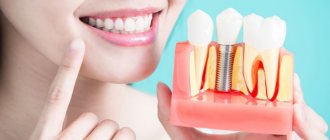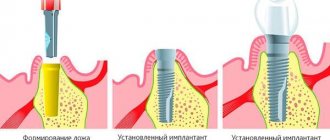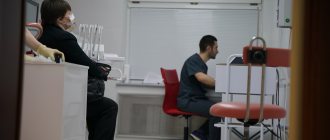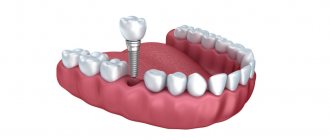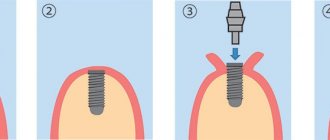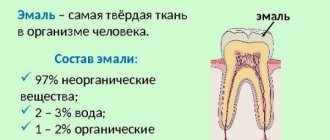The fear of going to the dentist, which has become entrenched among several generations of Soviet people, forces even young people to postpone dental restoration “for later.” Meanwhile, the loss of even one or two teeth triggers the process of serious changes in the dental system. And eliminating the resulting negative consequences over time will require quite a lot of effort and financial investment. Modern dentists have at their disposal an effective technology for replacing lost teeth, based on implanting artificial dental roots into the jawbone. Moreover, in many cases, treatment can be carried out in an extremely short time and with minimal discomfort.
Contents of the basal dental implantation section:
- Benefits of the basal method
- Installation video
- Engraftment of implants
- Advantages
- Photos before and after treatment
- Features of the method
- Stages of implant healing
- The history of the implantation method
New teeth in 3 days - all inclusive! And you can chew!
Implantation with immediate loading of a prosthesis - 44,000 rubles. for a unit.
Installation of a complete metal-ceramic bridge prosthesis on one-stage implants of the ROOTT system (1 jaw) - RUB 210,000. 250,000 rub.
Only our center has an exclusive franchise for the use of the ROOTT immediate load implantation method in Russia.
Single-stage implantation: how to care for teeth after surgery
First of all, you should follow the recommendations given by the implantologist. The specialist, based on the patient’s condition, either recommends limiting the load on the “new” tooth and trying not to involve it in the chewing process (if the condition of the tissues in the implant installation area causes concern, the crown is not installed at all until stabilization), or, on the contrary, loading it in to the fullest.
After the implants have implanted, caring for the prosthesis is usual: hygienic cleaning twice a day and the use of dental rinses to prevent periodontal diseases. It’s a good idea to get an irrigator (a device that allows you to clean the interdental spaces with a stream of water) and special brushes (it’s better if a hygienist teaches you how to use them). A patient who has undergone immediate dental implantation should visit the dentist at least twice a year and monitor his health, since infectious, chronic and inflammatory diseases can cause rejection of artificial roots.
Advantages of the basal implantation method
The unique feature of the method is determined by the method of implanting implants into the deep basal layers. These tissues are practically not subject to atrophic processes, unlike the alveolar spongy layer. As a result, it is possible to install implants using the basal method even in complex clinical cases, when alveolar tissues are atrophied, in patients with periodontal disease and other serious diseases.
Installation is carried out using the compression method through a puncture. This is a much less traumatic method compared to the need to saw through the bone for a plate implant or remove a flap of gum for a two-phase implantation.
Basal implantation is performed using monoblock systems, that is, the rod and abutment form a single whole. This made instant loading possible: immediately after implantation, a light bridge-like prosthesis is fixed on the top of the implant and included in the chewing process.
Being correct load conductors, such implants transfer normal pressure when chewing food to the bone layers of the jaw. This stimulates metabolic processes in them and activates osseointegration.
Due to the fact that the implant and abutment are a one-piece structure, FIXED dentures can be installed immediately. A person can forget about missing teeth or removable dentures, returning to a normal lifestyle within 3-4 days.
Implants, being conductors, evenly and correctly distribute pressure on the bone and among themselves, while stabilizing each other. The implant healing process is based on stimulating the natural processes of bone tissue restoration during the process of chewing food.
— As for the prosthesis, how functional is it and is it possible to achieve its aesthetics?
“With immediate loading, you can achieve the highest aesthetics - and this is one of our main goals: so that after treatment the patient not only eats well, but also enjoys his own reflection in the mirror. A permanent prosthesis is fixed on the implants, you can chew soft food with it immediately, the load must be gradually increased - on average, after a month the patient completely returns to his normal life. The prosthesis consists of crowns and has a small part of artificial acrylic gum - it does not at all interfere with the appearance of the prosthesis. On the contrary, it allows you to hide the shortcomings of the natural mucosa - its uneven contour, which is formed when bone tissue subsides and periodontal inflammation. Such a prosthesis must be worn for at least six months to a year until the implants are completely implanted in the bone. However, in practice we see that such prostheses serve quite successfully for 3-5 years.
Expert opinion
Igor Yurievich Malinovsky
Maxillofacial surgeon, implantologist
Experience: more than 11 years
Implantation with immediate loading combines a number of modern protocols, the essence of which is the almost instantaneous restoration of aesthetic and chewing functions of the dentition, mainly with multiple restorations. When implanting implants, not only cancellous bone tissue is used, but also deeper layers, both of the jawbone and of the skull. Due to this approach, basal dental implantation is carried out without additional osteoplastic interventions.
Risks of instant implantation
Like any other dental procedure, one-stage dental implantation has not only its advantages , but also its disadvantages. And the main negative point is associated with a higher degree of rejection of the structure, compared to two-stage dental implantation. At the same time, a positive result can only be obtained if the rules of the operation are strictly followed. Most often, the likelihood of rejection of an installed implant is due to the following points:
- Excessive plaque formation near the hole;
- Increased trauma to soft tissues after extraction;
- Insufficient reliable fixation of the structure;
- Implementation of simultaneous loading with a temporary prosthesis.
FEATURES OF IMPLANTS FOR IMMEDIATE LOADING
HOW IMPLANTS WORK WITH BONE TISSUE
- The cortical plate is a narrow protective shell layer, 95% consists of mineral salts, and accordingly is hard and practically does not dissolve;
- The alveolar region (spongy) is a softer layer of bone, 70% consists of bone septa and crossbars, between which capillaries pass. This section is most susceptible to inflammatory processes and bone resorption in the absence of chewing load;
- The basal section is a deep layer of bone, which is denser and stronger than the previous two and is least susceptible to atrophy. It is this department that is used by specially created implants for cases of severe bone tissue deficiency. Thanks to a special thread, according to indications, the rods are attached, including in the cortical plate, which gives them greater stabilization and uniform load distribution based on the principle of support at 5 points.
Before performing basal implantation, the doctor individually models the structure so that the distribution of pressure during chewing is uniform. In combination with basal implants, compression ones are used, which work with the alveolar region and can be installed at different angles to give the entire structure stability sufficient to withstand immediate chewing load. When such implants are implanted, the alveolar region is subject to compaction (condensation), forming a dense (cortical) layer around the implant. This layer does not dissolve for a long time and serves as the foundation of the product until the new bone absorbs it. The final stabilizer of the structure is the fixation of the prostheses 3-4 days after installation of the implants. This technology allows you to restore the roots of teeth even in complex cases of bone tissue atrophy.
Do not forget that the bone structure of each patient is individual; there are cases of atrophy when the implantation of any implants is not indicated without additional manipulations to build it up (the bone can be atrophied even up to 1-2 millimeters in height or width). Such cases are extremely rare, however, even after bone grafting, the overall period of dental restoration can be significantly reduced, since prosthetics on basal implants is performed after implantation, and not after several months, as with the classic protocol with delayed loading.
Doctors' opinions on two-stage dental implantation
This technique is considered the most reliable. This is due to the fact that the implant is isolated from bacteria by completely suturing the mucous membrane. Thus, the risk of developing peri-implantitis (inflammation of the soft tissue around the implant) is minimized. But there are also disadvantages, the main one of which is secondary surgical intervention.
A two-stage operation is advisable in the following cases:
- it is planned to load the implant after 3-6 months;
- the patient is a smoker (the second safe option for people with this bad habit is basal prosthetics);
- the presence of pathogenic processes in the oral cavity (insufficient hygiene, chronic inflammatory processes, etc.);
- if the patient requires bone grafting or installation of a barrier membrane (it is used for directed bone regeneration);
- Insufficient thickness of soft gum tissue (less than 2 mm). In this case, the doctor can augment the soft tissue using a flap obtained from the tissue of the palate. Thin gums can cause further recession and exposure of the implant neck.
BY CHEWING YOUR FOOD YOU HELP THE IMPLANTS TAKE PLACE
Instant chewing load is one of the key points of the technology, since implants act as conductors of chewing load, capillaries in bone tissue are activated, cells begin to receive proper nutrition and self-heal. Thus, in addition to restoring aesthetics and returning to normal food intake, patients also help the process of osseointegration (engraftment of implants in the body). In patients with severe facial asymmetry due to missing teeth, the bite is gradually restored, the facial muscles begin to work as before, and premature signs of aging disappear. Diction is restored, digestion and the general condition of the body as a whole are improved. The fact is that due to the absence of teeth, patients begin to avoid hard foods; as a result, less nutrients enter the body and metabolism is disrupted.
Reviews about one-stage implantation
This technique has proven itself as an effective and safe way to restore the aesthetic and functional components. It is used if you plan to put an early load on the implant. But it also has risks. This method increases the risk of developing bacterial infections. The possibility of developing peri-implantitis is due to the fact that the abutment is not covered with mucous membrane, which protects against pathogenic microorganisms entering the wound surface.
Therefore, this technique is not applicable for patients at risk. It should not be performed on smokers or patients with reduced immune function (including diabetes mellitus). It is also contraindicated for people with chronic inflammatory processes occurring in the oral cavity, and for those who neglect the rules of hygiene.
IMPLANTATION STAGES WITH IMMEDIATE LOADING
- preparing the patient and oral cavity for surgery;
- modeling of an individual design of implants to suit the specifics of the patient’s case.
- If there are movable teeth that cannot be restored, they are removed and implants are immediately installed in their place.
- If teeth are already missing, then the bed is formed using a puncture method, and then the implants are implanted into the bone using the compression method;
- The orthopedic doctor makes an impression, models and manufactures the prosthesis;
- the tops of the implants (abutments) are fixed at the required angle for subsequent installation of the prosthesis;
- on the third day after implantation, a permanent metal-plastic prosthesis is installed on the structure, which is adjusted to the patient’s bite;
- the patient can begin to use the new teeth.
VIDEO REVIEWS OF PATIENTS - WATCH HOW THE OPERATIONS GO
Which dental implantation is better: one-stage or classic?
Single-stage dental implantation has significant differences from the standard procedure, which is performed in several successive steps.
First of all, the difference lies in the degree of tissue trauma. In the case of the traditional method, it is an order of magnitude higher, due to a greater number of operations. The same applies to the number of rehabilitation periods: when immediate dental implantation is performed, there is only one recovery stage, in the second case their number reaches two.
Another distinctive feature is the gap between tooth extraction and fixation of the dental implant. If with an instant procedure it is reduced to one surgical intervention, then with the standard method it is equivalent to a 6-week period. There is also increased comfort during instant manipulation compared to the usual method of restoring teeth.
DIFFERENCES AND ADVANTAGES OF DENTAL IMPLANTATION WITH IMMEDIATE LOAD
| DIFFERENCES | ADVANTAGES |
|
|
New teeth in 3 days - all inclusive! And you can chew!
Implantation with immediate loading of a prosthesis - 44,000 rubles. for a unit.
Installation of a complete metal-ceramic bridge prosthesis on one-stage implants of the ROOTT system (1 jaw) - RUB 210,000. 250,000 rub.
Only our center has an exclusive franchise for the use of the ROOTT immediate load implantation method in Russia.
Implants for immediate loading
Installation of an implant on the ROOTT system in Russia is carried out only in ROOTT centers. We are official partners of TRATE AG in Russia, installing only high-quality and time-tested implants developed on the basis of research by the European Open Society of Dentistry, with the participation of domestic colleagues from the Russian Association of Implantologists.
The size, shape and method of installing the rods are selected strictly individually according to medical indications. Basal surgery can take place in a one-step format immediately after tooth extraction in 1 appointment.
Read more in the article why the ROOTT implant system. Read more in the article why the ROOTT implant system .
How one-stage implantation is carried out at the St. Petersburg GrandMed clinic
Simultaneous implantation is a planned operation for which the patient must be prepared. Tests, sanitation of the oral cavity and x-ray examination are mandatory, since this technique is used under “ideal” conditions: the gum is healthy and fits tightly to the underlying bone, the bone tissue is free of signs of atrophy, and on the roots of the tooth to be replaced (we are talking about implantation immediately after removal) there are no formations characteristic of periodontitis.
Operation stages:
- Removal of a decayed tooth. A stage on which the outcome of implantation directly depends: if inflammation develops after unsuccessful removal, which is not uncommon, the implant will be rejected. To minimize risks, one-stage implantation is not carried out in cases of emergency tooth extraction (if the tooth hurts, then inflammation has already occurred) and when removing teeth with cystic formations on the apexes of the roots. The tooth is extracted very carefully, trying to prevent the gum mucosa from detaching from the bone tissue.
- Inspection of the hole. For successful simultaneous implantation, the condition of the jaw bone tissue is crucial. The implantologist judges its quality and volume by X-ray and tomography results, but these data are still not enough to make a decision on the advisability of the operation, therefore, immediately after tooth extraction, the specialist tests the density of the jaw bone to determine the ability to hold the implant with the prosthesis installed on it . For this, a device is used that measures the force of screwing in the implant - it must be at least 30 Ncm. A higher figure is welcome, but if it does not reach the specified value, then the express method will have to be abandoned.
- Implant installation. The artificial root is placed in a hole, the diameter of which in most cases does not coincide with the diameter of the implant. If the hole needs to be widened, this is done not with a drill, but by rotating a dental chisel, which does not remove tissue, but only moves it to the side. After the procedure is completed, they will return to their place, thereby helping to strengthen the implant. If the hole, on the contrary, is too wide, then it is augmented, that is, filled with a special material that promotes “ingrowth” of the implant.
- Fixation of the crown. Depending on the specific situation, the prosthesis may be temporary, made of plastic. Typically, such a crown is made shortened so that there is no contact with the opposing tooth and the load that occurs during chewing does not interfere with wound healing. The permanent temporary crown is replaced after two months.
HISTORY OF THE IMMEDIATE LOAD IMPLANTATION METHOD
This implantation method originates at approximately the same time as the classical one, but due to the fact that the commercial wave picked up the classical protocol, it is more common these days. But the more people suffer from bone atrophy, as well as the inability to restore teeth in an acceptable short time, the faster new approaches are developed. In 2011, the European Open Dental Society (ODC) together with the Institute. Tramonte, dr. Tomasz Grotowski (follower of the basal implantation school created by Dr. Garbaccio) and other colleagues, adherents of the Immediate load technique, improved the structure and technology of implantation. Their developments formed the basis for the creation of the ROOTT implantation system by the Swiss company TRATE AG. Being a member of ODC and taking an active part in developments, the center became the first clinical base in Russia to use the new technique on an exclusive basis
Contraindications and complications for dental implantation
Like any other surgical intervention, the manipulations described above have a number of contraindications. They are divided into absolute and relative.
Absolute contraindications include:
- diseases of the hematopoietic organs and blood diseases;
- the presence of malignant neoplasms;
- pathological processes in the immune system;
- diseases of the central nervous system;
- autoimmune diseases (lupus erythematosus, etc.);
- taking medications based on biphosphates;
- rheumatoid arthritis, rheumatism and scleroderma;
- tuberculosis;
- revealed hypertonicity of the masticatory muscles;
- recurrent aphthous stomatitis;
- type 1 diabetes mellitus and uncontrolled type 2 diabetes mellitus.
Relative contraindications are considered to be:
- ignoring the rules of oral hygiene;
- the presence of pathological processes in the oral cavity (carious lesions, pulpitis, etc.);
- an addiction such as smoking can significantly complicate the implantation process;
- improperly formed bite;
- bruxism (a pathology in which teeth grinding occurs);
- Osteoporosis is also included in the group of relative contraindications, since there are currently implant models designed for low-density bone tissue.
I would like to focus special attention on smoking. This bad habit can cause all sorts of complications and cause complete rejection of the implant. The ideal option would be to completely quit smoking.
If such a radical way of eliminating risks is unacceptable for the patient, then there is a second way. A competent choice of implantation technique allows you to reduce possible negative scenarios. For them, the best option would be the basal implantation technique.
If this method cannot be implemented for some reason, then the doctor will suggest a two-stage implantation. As described earlier, the implant is tightly closed with mucous tissue, which minimizes the risk of developing infections.
Where to go for basal dental implantation in Moscow
By choosing single-phase dental implants, we can count on a beautiful smile after the first visit to the dentist. Immediate loading implantation provides this unique opportunity.
Compared to classic implants, the basal implantation process takes much less time. Monoblock implants are immediately covered by a temporary prosthesis, so you don't have to wait months for a crown, bridge, or full denture to be placed on the implant. During the procedure, there is no need to cut the gum, and the absence of an abutment adapter between the implant and the crown eliminates possible problems arising from loosening of individual structural elements.
You can consult about basal implantation in Moscow at various dentists. Make your choice consciously, giving preference to the most reputable medical institutions. You can navigate the price level by studying the list of dental implant clinics presented below.
| Name | Clinic address | Service cost |
| ROOTT |
| Installation of a one-stage implant (Switzerland, Trate AG) with an adaptation crown - RUB 38,000. |
| Shandora | Moscow, Kolpachny lane, 6, building 4. |
|
| Dentistry Grand Smile | Moscow, st. Miklouho-Maklaya 43 (metro station Belyaevo, Yugo-Zapadnaya, Kaluzhskaya) | Astra Tech implants (Sweden) from 45,000 rubles |
| Dentistry MEDIKASTOM | Moscow, st. Znamenskiye Sadki, 1, K.1 (M. Dmitry Donskoy Boulevard) | Implantations NOBEL BIOCARE (Sweden) from 45,000 rubles |
| Dentistry "Doctor Martin" |
| From 65,000 rubles per tooth using Nobel screw systems |
We remind you that the success of dental restoration, including using basal implantation, largely depends on the patient’s behavior after surgery. Despite the fact that implantation with immediate loading is as gentle as possible, and the recovery period is fast, there are strict recommendations in this regard:
- After implantation surgery, do not eat or drink for 1-2 hours.
- Proper oral hygiene is extremely important, that is, thorough brushing of the teeth, but being as gentle as possible in the wound area.
- Do not use mouthwash unless your doctor tells you otherwise.
- Do not use any stimulants: alcohol and cigarettes.
- On the first day after the procedure, avoid physical activity, sauna, gym, swimming pool and hot baths.
Other jobs
How much does an immediate load on 6 cost in Moscow?
The price of the service depends on the implant manufacturer. Israeli implants and their installation will cost from 250 thousand rubles, Korean ones - over 300 thousand rubles, the price of Swiss implants from Nobel Biocare ranges from 450 thousand rubles.
In addition to the implants themselves, the cost of the service includes:
- X-ray diagnostics and creation of a 3D model of the jaw
- taking an impression of the jaw
- installation of implants
- making an acrylic prosthesis from an impression
- installation of a prosthesis.
Total prosthetics prices
Immediate loading on 6 Israel implants (implants + prosthesis)
250,000 rub.
Examples of work “Before” and “After”
Complex one-stage implantation of the lower jaw
Case: there was a loose bridge of 4 front teeth on the lower jaw; after diagnosis, removal of the remaining teeth and complex basal implantation were prescribed.
Dental restoration using basal implantation method
Case: complete absence of teeth in the upper jaw, bone atrophy.
Restoration of all teeth using basal implantation method (March 2012)
Case: partial adentia, exposed roots of natural teeth, periodontitis, increased tooth mobility, severe atrophy of bone tissue in some places beyond the possible norms for classical dental implantation.
Restoration of anterior teeth using basal implantation method (April 2012)
Case: partial absence of front teeth and destruction of supporting teeth under the prosthesis, the relief of the gums and interdental papillae is disturbed.
Comparison of techniques
| Classical | One-stage | One-step | |
| Implant installation method | Flap - with peeling of the gum to access the bone | Transgingivally - through a puncture of soft and bone tissues | In the socket of an extracted tooth |
| Type of temporary prosthetics | A removable denture that is fixed to adjacent teeth | Temporary lightweight crown on an implant with bite relief | Removable denture or temporary crown on an implant |
| Duration of temporary prosthetics | 2-6 months before implant implantation | 2-6 months before implant implantation | 2-6 months before implant implantation |
| Formation of the gingival contour | Before permanent prosthetics | Not carried out | Depends on the type of prosthetics |
| Type of permanent prosthetics | Zirconium dioxide crown | Zirconium dioxide crown | Zirconium dioxide crown |
All three methods are painless, are performed under local anesthesia or sedation, and the patient does not feel any discomfort.
The same preparation is carried out, there is no difference in the required examinations. To identify contraindications, the following is carried out:
- taking anamnesis;
- inspection;
- CT scan.
The contraindications are the same:
- uncompensated diabetes mellitus;
- oncology;
- osteoporosis;
- bleeding disorders;
- tuberculosis;
- mental disorders.
But patients are more interested in the ability to quickly recover a lost tooth completely. According to this criterion, two methods differ - classical and one-stage. The one-stage method after removal is continued according to one of the protocols - with delayed or immediate loading.
Possible nuances of one-stage implantation
The risk of rejection due to overload is one of the main nuances. For example, if the patient does not follow the doctor’s recommendations or tried to eat something solid during the period of active implantation.
Note! To prevent displacement or loosening of the implant in the initial period after implantation, you can use a special protective abutment. The essence of its work: if there is a large load on the crown, the upper plastic cap is separated from the abutment, while the implant itself will remain motionless in the bone. The abutment, as it were, takes on all the risks of overload, limiting the pressure on the titanium implant.

